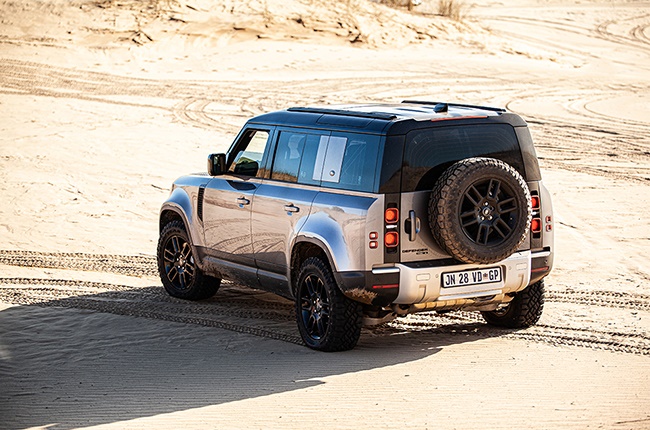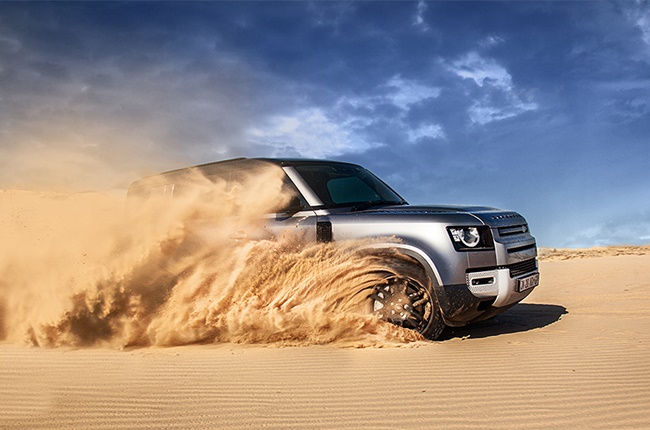• RoadTrip takes the new Defender on a sojourn on its South African roots.
• The team drives the new top 110 P400 S model.
• The new Defender came together with a Series I Defender.
• For more motoring stories, go to www.Wheels24.co.za
It was 70 years ago - in August 1950 - when the first Land Rover Series I was assembled in Frontier Country. We traced the production path of local Land Rovers, including the original Defender, with a highly accessorised new Defender 110 P400 S and met up with an impeccably preserved Series I on the way.
The immaculate little 1953 Series I 80-inch Land Rover, perfect in its traditional dark green, lined up to face the new Eiger Grey Defender 110 over the edge of the waterhole - a scene depicting 70 years of automotive "progress" in one frame.
I use the term "progress" with hesitation, as the old short-wheel-base Landy in its most basic form looked more comfortable in the surroundings than its much bigger modern counterpart. The little Eighty looked like it belonged there, as if it was part of the African landscape, while the shiny new Defender looked decidedly out of place.
Seeing an old Series I like this immediately conjures up images of intrepid safaris and audacious journeys through the wild, dark African bush. This has been romanticised over decades past and cemented the iconic status of the boxy little 'un in off-road folklore.
We were at Schotia Safari Private Game Reserve, close to Paterson in the Eastern Cape, where we met Peter and Justin Bean and their trusty, immaculately maintained Series I. At first glance, it was remarkable to see the difference in gait between the original and the new Defender.
Small it may be, with a trifling 2.0-litre engine delivering a measly 39kW at 4000rpm and 137Nm of torque at 1500rpm. Yet, after the little mill popping and banging whirred into life, the little bushwacker with its huge steering wheel (something we disliked in the new Defender) bounced and bounded to wherever we needed it for our photoshoot.
To read the original story, click here.
Historic times
Watching the archetype model traversing the bush took one back to simpler times when the original derivative first saw the light. The reason for our visit to Schotia, was to celebrate the assembly of the first Land Rover locally (most probably a similar mid-Series I model) - we were on a journey from Buffalo City towards Cape Town in the recently introduced new Defender.
The first Series I landed in South Africa in 1949, only a year after it was officially introduced in Europe. It took only another year before the first locally assembled Series I rolled off the production line of the Car Distributor Assembly (CDA) plant in the Eastern Cape.
According to most sources, this vehicle was constructed in Port Elizabeth, but this does not make sense, as the CDA plant was opened in East London in 1948 to assemble Nash, Prince, and Miller cars, and had no facilities in Port Elizabeth. Thus, it follows that the first local Land Rover was, in actual fact, built in Frontier Country, in East London, and not Port Elizabeth.
CDA produced Series Land Rovers from 1950 to around 1956. Meanwhile, Rover South Africa was registered on 28 September 1955, and a manufacturing plant subsequently opened in Port Elizabeth. In 1956, the plant assembled a peak of 34 vehicles per week and, by 1963, the facility, in line with local content requirements, was making chassis and petrol tanks from South African steel.
However, with the acquisition of Rover/Land Rover by Leyland and the subsequent merger with BMH (British Motor Holdings) in 1968 to form British Leyland, production moved to Cape Town. Here, assembly continued until 1987. By 1972, the local content of Land Rover had reached 44% in vehicle weight, and in 1982 the Leyland (Leykor) plant was recognised as the largest Land Rover assembly plant outside the United Kingdom.
2020 Land Rover Defender (Ryan Abbott / RoadTrip)
Mild hybrid power
For our journey, we were furnished with an attractive 110 P400 petrol model. It was kitted in striking Eiger Grey (adding R4 000 to the purchase price) with Urban Pack (R20 443), Gloss Black six-spoke 19-inch wheels (R4 200), black contrast roof (R8 000), sliding panoramic roof (R30 200), black exterior pack (R4 900), front fog lights (R2 000), and deployable tow bar (R13 200).
Inside the already plush cabin, extras such as 12-way semi-powered front seats, third-row seats, three-zone climate control with rear cooling, configurable Terrain Response 2, and an array of driver aid systems, as well as an Electronic Active Differential added another R40 600 to the total price.
The accessories, totalling R74 400 over the cost price, also included some cool items, such as air quality sensors and cabin air ionisation, Keyless Entry, and the ClearSight interior rear-view mirror - an indispensable piece of kit to have a clear view past the rear-mounted spare wheel.
The Urban Pack brightwork added bright metal pedals in the interior, scuff plates, a spare wheel cover, and a front under-shield, and all this, plus the outsize Goodyear Wrangler all-terrain tyres gave the Defender a stylish look, but with a belligerent, militant stance.
The no-nonsense attitude of the flagship 110 model was further strengthened by the soft growl of its new 3.0-litre straight six-cylinder engine (the first Land Rover with this powerplant in the country) featuring mild-hybrid electric technology and delivering a healthy 294kW of power and 550Nm of torque.
Leaving from the East London JLR agents, Eastern Cape Motors (the company that evolved from the erstwhile Manning Motors, one of the first Land Rover dealerships in South Africa in 1951), we chose the twisty coastal route towards Port Elizabeth.
On the meandering tarmac, it was soon clear the P400 possesses ample power (Land Rover claims a 0-100km/h sprint time of 6.1 seconds and a limited top speed of 191km/h) but assistance from the hybrid system was never really evident.
With its self-levelling air suspension and bespoke underpinnings, the Defender was quite nimble in the corners - despite its weight - and a consummate companion on the highway. After our visit to Schotia, we skirted Port Elizabeth on the N2 (as in our research we could find no exact location for the erstwhile Rover plant in the Windy City) and made our way towards St. Francis Bay.
2020 Land Rover Defender (Ryan Abbott / RoadTrip)
Off-road prowess proven
Our next destination was Brakkeduine 4×4 Trail, close to Oyster Bay - to give the new Defender a proper four-wheel-drive workout. Here we were met by Johan Lindstrom, a man with many years of 4×4 experience, who took us out on the challenging dune route.
With its combination of the advanced Terrain Response system, powerful engine, fast-reacting transmission, and favourable overhang angles, the Defender - while quite big and heavy - made short work of the tricky dunes and deep sand. The grip of the specially developed Goodyear tyres was surprising, and even Johan was impressed with the capabilities of the Solihull newcomer.
From there we quickly made our way on the Garden Route through Knysna, George, and Mossel Bay, securely ensconced in the roomy, quiet, and dust-free 5 + 2 cabin. We wanted to round off our tour to Cape Town by crossing the Breede River on the Malgas pontoon (a favourite jaunt for Landy drivers over the years) but we had to bypass it as the new pontoon is not in operation yet, and it is unclear when it will be.
On the myriad dusty dirt roads in the Overberg District, the new Defender again impressed with its ride quality and cabin quietness and we finsihed our trip with a quick deviation through Elsies River, Epping, and Blackheath - the locations of the Leyland plants back in the day.
Interestingly, most of the records of Landies built here have been lost or destroyed (causing huge problems for buyers of used locally built Series II and Series III models) in part due to many (with local ADE engines) being supplied to the military during Apartheid.
2020 Land Rover Defender (Ryan Abbott / RoadTrip)
Moving up North
With the demise of Leyland and BMW taking ownership of the Rover Group, production of Land Rovers (now called Defender) moved to a new plant in Rosslyn, Pretoria, inaugurated in January 1995. This continued until 2000 when BMW sold the marque to Ford.
Assembly then moved to Silverton, and final Defender production included a 5.3m-long 11-seat variant with three sets of side doors before it was discontinued in 2002. (Quite a few unique Land Rover derivatives were built in South Africa, and they are now highly collectable, but this is a story for another day). From late 2002, all models were imported until worldwide production seized in 2016.
So, can the new, completely modernised Defender fill the big tyre tracks of its predecessor? Well, yes and no. While utterly capable off-road, it will probably not satisfy the needs of traditional overlanders and adventurers, but it will appeal to those (mainly Discovery owners) wanting something styled more "old-fashioned".
Besides this, its high price (starting from R1 050 100 for the 110 derivatives, and our test model with extras selling for R1 425 221) can be prohibitive. And it will also dissuade owners to really exploit its full bush-busting potential. It does not fit into the Africa adventure aura category (yet), and it will probably take many years before the newcomer will achieve the same level of respect afforded its basic, rudimentary, crude, yet characterful predecessor.
2020 Land Rover Defender (Ryan Abbott / RoadTrip)
Specifications: Land Rover Defender 110 P400 S Urban Pack
Engine: Six-cylinder, inline, petrol turbo, MHEV
Capacity: 2996cc
Maximum power: 294kW @ 5500rpm
Maximum torque: 550Nm @ 2000 - 5000rpm
Transmission: Eight-speed automatic, AWD
0-100km/h: 6.1 seconds
Top speed: 195km/h
Fuel capacity: 90L
Fuel economy: 9.9-litres/100km (claimed)
CO2 emissions: 227g/km
Boot space (max): 743L to 1826L
Ground clearance: 218mm (291mm off-road)
Wheels: 19-inch alloy (Urban Pack)
Tyres: 255/65R19 Off-Road
Max towing weight: 3000kg
Max wading depth: 900 mm
Price: R1 224 200 (base) | R1 425 221 (with option packs)
We like: Iconic, stand-out styling, comfort, high equipment level, practical, powerful, off-road prowess.
We do not like: Too advanced and refined for a Defender, high fuel consumption, big steering wheel (hindering off-road control).
RoadTrip rating: 84%




 Publications
Publications
 Partners
Partners
















